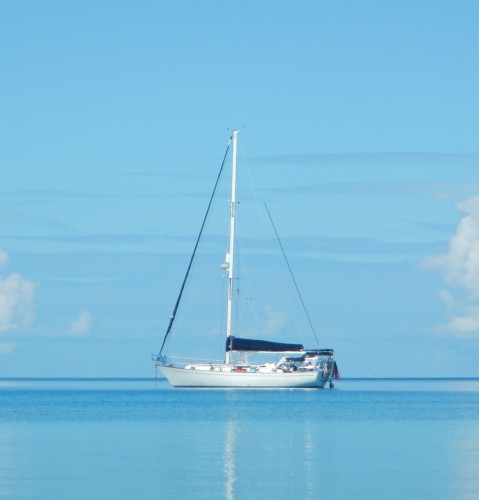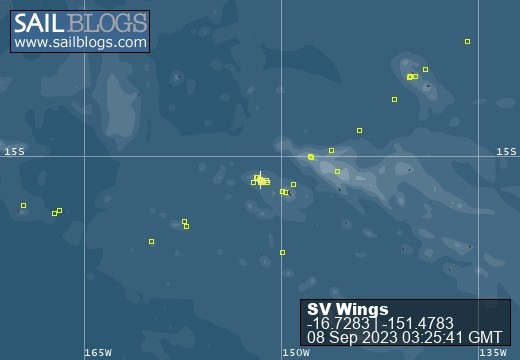
Voyages
These are the voyages of the sailing vessel, Wings.
19 September 2023 | Pension Tiare Nui
15 September 2023 | Pension Tiare Nui
13 September 2023 | Pension Tiare Nui
11 September 2023 | Pension Tiare Nui
07 September 2023 | Apooiti Bay
03 September 2023 | Tapuamu, Taha'a
02 September 2023 | Tapuamu, Taha'a
31 August 2023 | Haamene Bay, Taha'a
29 August 2023 | Relais Mehana Hotel, Huahine
26 August 2023 | Fare, Huahine
19 August 2023 | Aloe Cafe, Viatape
13 August 2023 | Aloe Cafe, Viatape
11 August 2023 | Apooiti Bay
11 August 2023 | Apooiti Bay mooring field
08 August 2023
08 August 2023 | Apooiti Bay, Raiatea
05 August 2023 | Raiatea Carenage
01 August 2023 | Raiatea Carenage
31 July 2023 | Raiatea Carenage
28 July 2023 | Orion Guest House
We're in Rarotonga!
24 May 2014 | Avarua Harbor, Rarotonga, Cook Islands
Happy Bill
We lose Nate here, much to our disappointment, He's been wonderful crew, jumping to do anything asked of him, and looking for tasks that he can do for us. He took to the schedule of watch keeping with ease and made the five-day crossing very easy for us. Thank, Nate. You're invited back.
We left Bora Bora in midday, motoring through the reef pass. We raised sails just outside the reef and sailed away from Bora Bora, starting a five-day crossing of 535 nm to Rarotonga. The solar panels worked well, the water generator worked well, and the Hydrovane steering worked well, reducing the needs of a watch to doing just that: watching for other vessels or dangers.
Speeds were up and down but maiming in the 4-5 knot range, so we usually made enough energy from the water generator to keep up with the use. Electronics also worked well other than than the one that transmitted our AIS information to the chart plotter. Drat.
As always, one day oozes into another and days seem to pass quickly. With few incidents to solve, we read, talked, ate, and slept our way through the days. Zipping through the Pacific ocean, day and night, is a magic thing to do. Night watches with the Southern Cross blazing in the Milky Way, bioluminescence in the water making blue-green fire around the boat…all add to the life on a passage.
We fought a storm the last night and the storm was part of front that turned the wind 180° and made it unusable for us. On with the motor and we motored the remaining 20 hours or so. We arrived before daybreak on Friday, and with a new harbor on an island that we've never seen, we always opt for the safety of passage with daylight. Down to the waiting game for me as it was my watch. We arrived at 0500 and daylight couldn't fight through the storm clouds until almost 0700, so I drove in long lazy circles for several hours while watching the radar for other vessels. When daybreak finally appeared, we finally contacted the harbor master and requested entry permission. With that finally granted (they didn't come on duty until 0800!), we easily negotiated the entrance and were faced with our first Med mooring. Mediterranean mooring is what the rest of the world uses for boats, since there are no fingers that define the width of a vessel that can fit. One drops anchor a few boat lengths from the dock, then backs toward the dock. At some point, lines are passed to the waiting dock helper and the boat is made fast. In most cases, planks or fancy ramps are deployed to reach the dock, but here the dock is made for commercial vessels and we had to inflate and deploy our dinghy to get ashore. The Customs and Health officials also visited the boat, the Health official spraying that boat's interior with methyl bromide to kill insects that might come ashore with us. I completed paperwork aboard as captain, and Conni completed paperwork ashore as ship's owner. Finally, we were entered and could complete boat chores before taking a tour of the island.
We sauntered along the main road along the island's circumference, enjoying the ocean on one side and jungle on the other. There's a small strip of flat land around the island and that's where people live and grow crops, although the Cook Islands are sparsely inhabited. 20,000 total, 10,000 on Rarotonga, and 4,000 in Avaroa where we docked. Everyone else lives in a village on some island.
Tourism to New Zealand is the main industry, it seems, but the islanders are Kiwis, too, and it's difficult to tell the difference between them by language alone. Everyone gets around by motor scooter with some cars, too. There's a cinema, stores, and a few tourist shops, but the island has kept its local feel to large extent.
The people are more Maori-looking but handsome, showing physical similarities to their Tahitian relatives. The non-white locals speak both their own language and Kiwi-inflected English and English is the official language. It does make it easier for us. NZ dollars are the official currency, but there is also locally-minted coinage that's accepted here and only here. Prices are considerably less than in French Polynesia, including food, alcohol, and such.
We left Bora Bora in midday, motoring through the reef pass. We raised sails just outside the reef and sailed away from Bora Bora, starting a five-day crossing of 535 nm to Rarotonga. The solar panels worked well, the water generator worked well, and the Hydrovane steering worked well, reducing the needs of a watch to doing just that: watching for other vessels or dangers.
Speeds were up and down but maiming in the 4-5 knot range, so we usually made enough energy from the water generator to keep up with the use. Electronics also worked well other than than the one that transmitted our AIS information to the chart plotter. Drat.
As always, one day oozes into another and days seem to pass quickly. With few incidents to solve, we read, talked, ate, and slept our way through the days. Zipping through the Pacific ocean, day and night, is a magic thing to do. Night watches with the Southern Cross blazing in the Milky Way, bioluminescence in the water making blue-green fire around the boat…all add to the life on a passage.
We fought a storm the last night and the storm was part of front that turned the wind 180° and made it unusable for us. On with the motor and we motored the remaining 20 hours or so. We arrived before daybreak on Friday, and with a new harbor on an island that we've never seen, we always opt for the safety of passage with daylight. Down to the waiting game for me as it was my watch. We arrived at 0500 and daylight couldn't fight through the storm clouds until almost 0700, so I drove in long lazy circles for several hours while watching the radar for other vessels. When daybreak finally appeared, we finally contacted the harbor master and requested entry permission. With that finally granted (they didn't come on duty until 0800!), we easily negotiated the entrance and were faced with our first Med mooring. Mediterranean mooring is what the rest of the world uses for boats, since there are no fingers that define the width of a vessel that can fit. One drops anchor a few boat lengths from the dock, then backs toward the dock. At some point, lines are passed to the waiting dock helper and the boat is made fast. In most cases, planks or fancy ramps are deployed to reach the dock, but here the dock is made for commercial vessels and we had to inflate and deploy our dinghy to get ashore. The Customs and Health officials also visited the boat, the Health official spraying that boat's interior with methyl bromide to kill insects that might come ashore with us. I completed paperwork aboard as captain, and Conni completed paperwork ashore as ship's owner. Finally, we were entered and could complete boat chores before taking a tour of the island.
We sauntered along the main road along the island's circumference, enjoying the ocean on one side and jungle on the other. There's a small strip of flat land around the island and that's where people live and grow crops, although the Cook Islands are sparsely inhabited. 20,000 total, 10,000 on Rarotonga, and 4,000 in Avaroa where we docked. Everyone else lives in a village on some island.
Tourism to New Zealand is the main industry, it seems, but the islanders are Kiwis, too, and it's difficult to tell the difference between them by language alone. Everyone gets around by motor scooter with some cars, too. There's a cinema, stores, and a few tourist shops, but the island has kept its local feel to large extent.
The people are more Maori-looking but handsome, showing physical similarities to their Tahitian relatives. The non-white locals speak both their own language and Kiwi-inflected English and English is the official language. It does make it easier for us. NZ dollars are the official currency, but there is also locally-minted coinage that's accepted here and only here. Prices are considerably less than in French Polynesia, including food, alcohol, and such.
Comments
| Vessel Name: | Wings |
| Vessel Make/Model: | Passport 40 |
| Hailing Port: | Anchorage, Alaska |
| Crew: | William Ennis and Constance Livsey |
| About: | We've been married since 1991, and both retired from our respective jobs (teacher and attorney) after long careers. We live in the most exotic of the United States: Alaska. We cruise on Wings for half the year, enjoying our home state the other part of the year. |
| Extra: | |
| Home Page: | http://svwings.com |
Wings's Photos - Main
No items in this gallery.
Who We Are

Who: William Ennis and Constance Livsey
Port: Anchorage, Alaska

